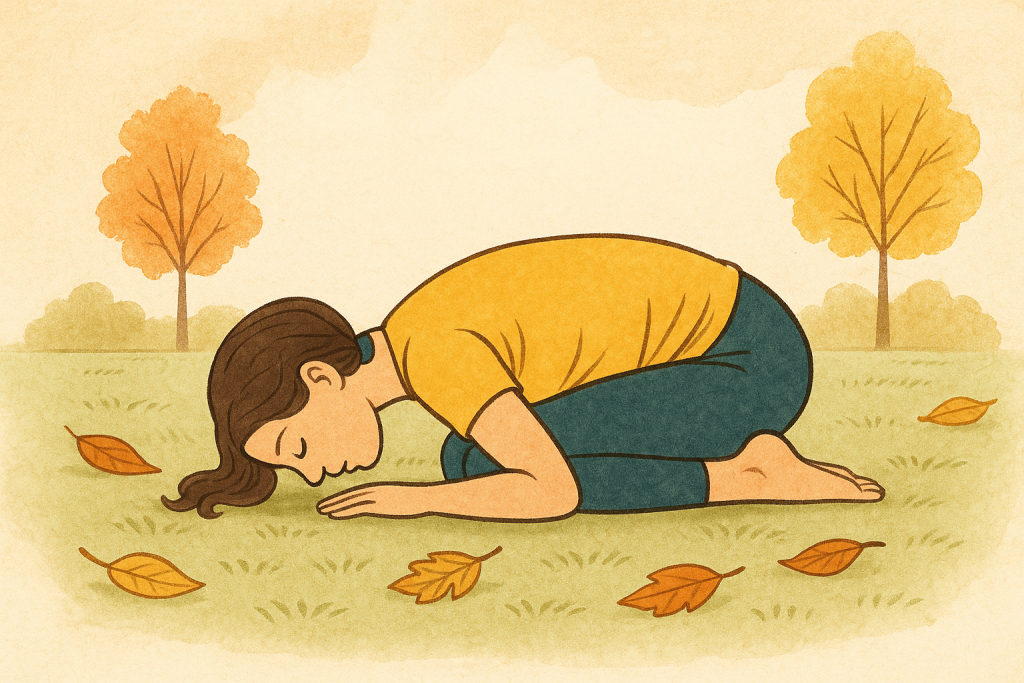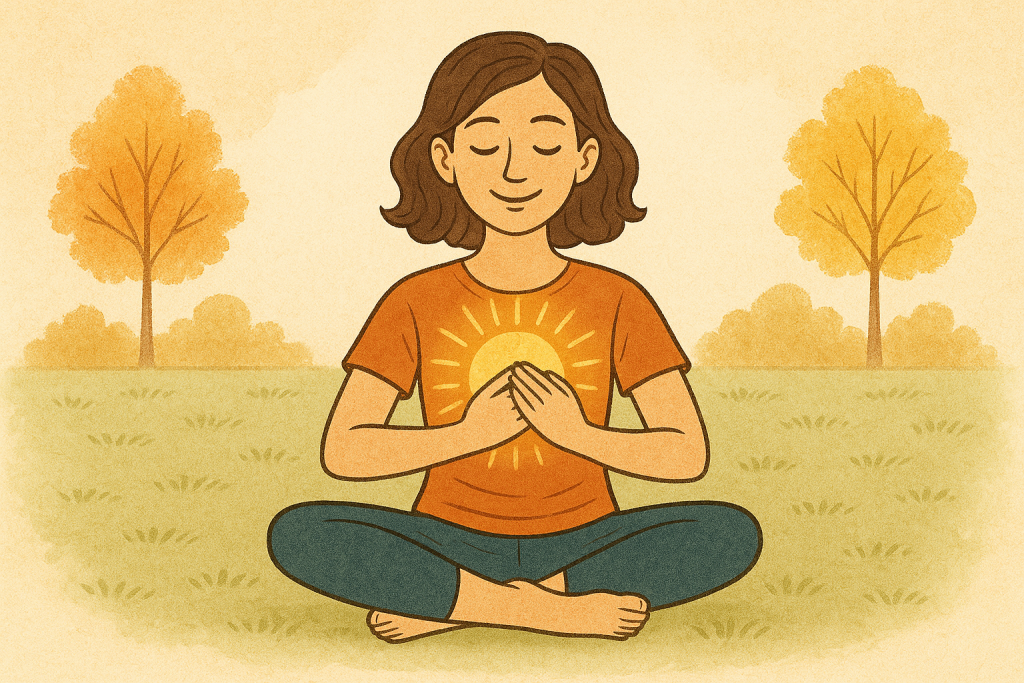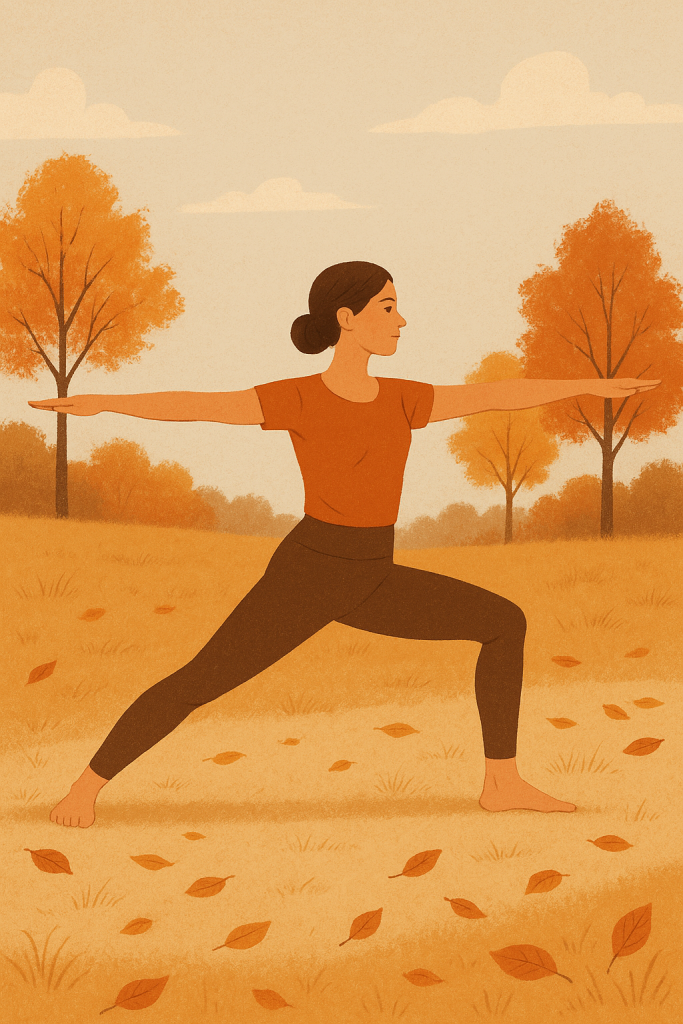Finding Balance: Staying Grounded as Autumn Begins
Summer is over, and with it ends a season that often feels lighter and freer. Suddenly the calendar fills up, work intensifies, and obligations increase. At the same time, the days become shorter, the weather greyer, and the prospect of many dark weeks can feel heavy. Maybe you know this feeling: everything seems to come crashing down at once.
Especially in this time of transition, it is essential to stay connected to yourself. If we only react to outside demands, we easily lose our inner balance. Yoga therapy and trauma-sensitive yoga offer valuable tools to navigate this seasonal change consciously—not with pressure or performance, but with gentleness, stability, and simple, healing routines.

Why autumn can feel so challenging
The shift from summer to autumn is not just an external change of seasons, but also an inner adjustment. The body reacts to less light and cooler temperatures, the hormonal balance shifts, and our nervous system processes rising demands.
Typical effects are:
- Tiredness and an increased need for sleep
- Irritability or mood swings
- Feeling overwhelmed more quickly
- Losing yourself in endless tasks and to-do lists
If we don’t pay attention to these patterns, they can lead to a downward spiral: we push ourselves harder, lose our grounding, and end up even more exhausted.
Yogic philosophy as a guide for mental health
Yoga is not only movement or relaxation—it is a way of approaching life. Especially in times of transition, yogic philosophy offers insights that support mental health and trauma recovery:
- Ahimsa – Gentleness with yourself
Instead of being driven by perfectionism, we can recognize that this is a challenging phase. Gentleness means: taking breaks seriously, not judging ourselves for being tired, and respecting our limits. - Pratyahara – Turning inward
Create small islands of silence—five minutes without your phone, a short meditation, or simply enjoying stillness. - Sthira sukham asanam – Stability and ease
This teaching reminds us that our inner posture requires both: structure and flexibility. Clarity and steadiness, but also the ability to let go. When both are in balance, true harmony arises.

Practical yoga therapy tools for autumn balance
Here are some concrete ways to bring yoga, bodywork, and self-care into your everyday life:
- Breathing exercises for clarity
Try lengthening the exhale: inhale through the nose for 4 counts, exhale through the nose or mouth for 6–8 counts. This calms the nervous system, supports self-regulation, and clears the mind. - Standing poses for grounding and stability
Postures like Mountain Pose (Tadasana), Warrior I & II, or Tree Pose (Vrksasana) help you feel strong and rooted, fostering stability during uncertain times. - Simple daily routines for resilience
- Get natural light in the morning
- Take mindful breaks
- Invite warmth into your day (tea, blanket, cozy space)
- Practice gratitude: each evening note three things that went well
Conclusion: Strengthening inner balance in autumn
Autumn doesn’t have to feel heavy or overwhelming. It can also become a time of gathering energy, stability, and clarity—if we allow ourselves to slow down and practice self-care. Trauma-sensitive yoga and mindful bodywork are powerful ways to strengthen the nervous system and support mental health during this darker season.
Perhaps in the coming weeks you’d like to create small islands of balance: a few deep breaths, a grounding yoga pose, or a short gratitude practice. These gentle tools help you stay stable and connected—even when the outside world feels demanding.

Als AddOn möchte ich das Yoga-Englisch-Angebot hier nicht vergessen: Gern auch als Newsletter mit wertvollen Inspirationen und Lebenserfahrungen 😊
I met Anna at the beginning of the Corona period and since then I have been booking online via Happy Lotus. I like her yoga style - depending on the needs and daily offer at different levels - rest, balance and strength training at the same time. Her diverse life experiences and her commitment to people can also be felt on the yoga mat: probably a calling! And so I always say goodbye to the yoga classes with a smile and gratitude. As an add-on, I don't want to forget the Yoga English offer here: Gladly also as a newsletter with valuable inspiration and life experiences 😊
den Einschränkungen, durch Corona .
Ich habe durch Anna ein ganz besonderes Yoga kennengelernt. Sie geht immer auf ihr Gegenüber ein. Die Übungen sind nicht zu lasch und nicht zu anstrengend, sondern es ist eine gute Mischung.
Und... Anna vermittelt alles mit so viel Liebe und Ruhe.
DANKE an die beste Yogafrau, die es gibt.
Happy Lotus, thank god there is Anna! I've been in Anna's yoga studio for over 2 years now and I'm soooo glad I have her. Especially the online classes were my salvation in Covid times. I have an online flat rate with Anna and can therefore go to one of her classes at any time. And I use that extensively. I've tried different teachers before, but I never stuck with them for long. Not so with Happy Lotus. Every lesson is a blessing. You can follow Anna's voice with your eyes closed. Anna also gives one-to-one sessions and has created a great personalized short sequence for me against my neck pain, I do it almost every day. Anna teaches in German and in English, I have attended every one of her classes and I am absolutely happy with Happy Lotus. All the stars in the world and a very clear recommendation from me!
Möchte die Trainings nicht mehr missen, absolut wohltuend - tolle Mischung aus Dynamik und Entspannung unter sehr sympathischer und kundiger Anleitung von Anna!!
Anna auf YouTube
Recent Posts
- Body-Based Support in Depression: Reflections from the German Depression League’s Thementag
- The Wisdom of Winter – Why Rest Is Not Withdrawal
- 🍂 Ritambharā Prajñā – When Truth Arises from Stillness
- Finding Balance: Staying Grounded as Autumn Begins
- When Everything Becomes Too Much – How Yoga Can Help Us Cope
Sign up now: Weekly Yoga Beginners Class (English)
New 8-class series starts in August. Register now! You have been wanting to learn Yoga,…

Trauma-Sensitive Yoga and Yoga Therapy: A Safe Path for Children and Adolescents – Especially in Times of Emotional Stress or Cancer
At first glance, many children seem carefree. But their world can sometimes be filled with…

Yoga gives you back control
Namaste, dear Yogis and Yoginis! It’s spring, the sun is coming out more often and…

